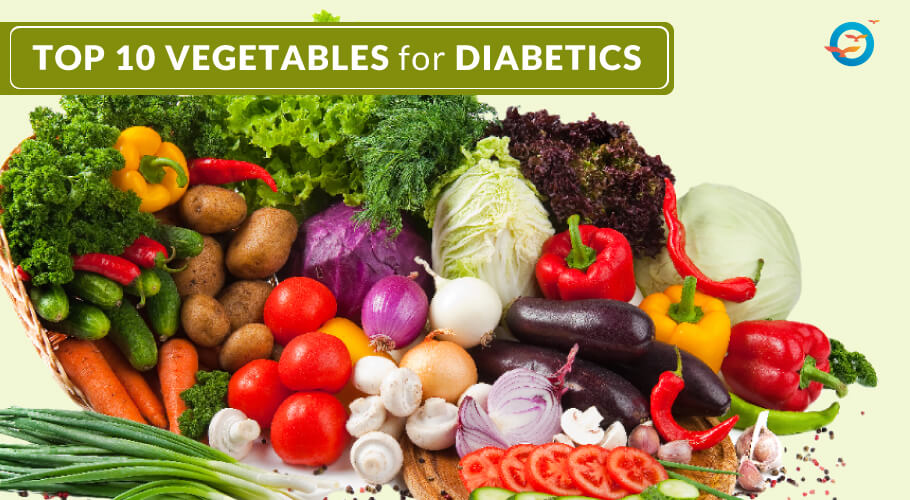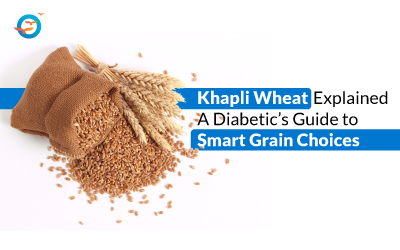Top 10 Vegetables for Diabetics

Vegetable for Diabetes
With the number of diabetes patients worldwide, and in India, spiralling out of control, more and more patients are turning to natural diabetes treatments to manage their blood sugar levels. This is understandable for several reasons. To begin with, conventional drugs do not actually treat diabetes, all they do is bring down your blood sugar numbers. This has long-lasting consequences, as the medicine & dosages inevitably rise, and as the disease progresses, the patient usually ends up on insulin, in increasing dosages.
This is because the real cause of diabetes, which is insulin resistance, goes unaddressed. There are several reasons why a person can become insulin resistant, and diet plays a huge role here. Here is the list of the top 10 vegetables for diabetics. With a proper diet, rich in essential vitamins, minerals, antioxidants, anti-inflammatories, and a variety of micronutrients, the body slowly begins to course-correct and improve its insulin insensitivity.
Vitamins and Diabetes
Lack of vitamins in their given Recommended Daily Intake (RDI) leads to health deficiencies that show up in a variety of disorders. The root cause is lowered immunity. Vitamin C, for instance, plays a key role in boosting immunity, reducing inflammation in the body, and safeguarding against viruses—such as the cold/flu coronaviruses.
There are many vitamins that the body needs, and just as many food sources.
Multi-vitamin Supplements—to use or avoid?
Chugging supplements has become a de facto immunity-building exercise today. But vitamins cannot and should not be consumed ad hoc. Of course, there are situations when one needs the boost that multi-vitamins provide. But, given the fact that they are available without a prescription, people tend to believe that they are safe.
But vitamins are not without risk. Especially when taken without a doctor’s recommendation. Many a time manufacturers package their multivitamins in ‘Megadoses’. These consciously exceed the RDI, relying on the belief that more nutrients mean more benefits. This is simply not true.
Side Effects of Multivitamins
As long as multivitamins are taken as directed, they are generally considered safe. Despite this, many people suffer from side effects ranging from common to more serious. These include:
- Constipation
- Loose motions
- Stomach upsets
- Nausea
- Headaches
- Nosebleeds
- Insomnia
- Allergic reactions_such as hives, swelling of the face, tongue, and many gut-related issues.
Children as especially at risk here. While water-soluble vitamins are relatively safe, as the excess gets flushed out along with waste from the body, fat-soluble nutrients and minerals build up in the body and cause toxicity.
Vegetables—the healthiest sources of vitamins and nutrients
Food sources offer a far safer and all-around better proposition for obtaining the vitamins and nutrients you need to stay strong and healthy. And vegetables score highest here. In addition to vitamins and minerals, vegetables are generally high in water content and fibre, both of which help your digestive system function smoothly. They also create a feeling of ‘fullness’, which leads to smaller food portions, and keeps hunger pangs at bay. This makes them excellent choices for weight loss.
How to consume vegetables?
Many people, vegetarians especially, may insist that they are already getting their nutrition through their diet choice. Which is only true to a point. Cooking destroys delicate micronutrients and enzymes and reduces the effectiveness of many nutrients. The ideal way to consume vegetables is raw. This can be through salads, pickles, and/or smoothies. You can also have only the concentrate of the vegetables—e.g. obtained through steeping for 4-5 hours.
While all vegetables offer many nutrients, some are more equal among others. The following are the 10 best vegetables for sugar patients who score high on our anti-diabetic chart. Read on to discover their health secrets.
Vegetables for type 2 diabetes
1. Okra (Bhindi, Ladyfinger)

The number one vegetables in our books is the humble okra. Known as ladyfinger or bhindi in India, the okra has long been popular as a health food. It is high in B Vitamins Vitamin C, folic acid, and calcium. In addition, it has a very low-calorie count and is high in dietary fiber, making it highly suitable for a diabetes Patient's diet.
Okra contains a viscous residue that is very effective in lowering BSL. Soaking a couple of ladyfingers—after slitting them—in water overnight helps extract this residue. Drinking it on an empty stomach, in the morning can help you start your day with a lower blood sugar level. (BSL). To Read More Click Here
2. Bottle Gourd (Lauki, Doodiya Bhopla)

The bottle gourd is a familiar site in Indian kitchens. Known colloquially in the Indian subcontinent as Dudhi Bhopla or Lauki, the bottle gourd (Lauki) has many health-enhancing properties. It is high in fiber, low in fat, with a very small calorie count. It is also believed to help improve liver function. All of which make it an ideal food for diabetes patients.
The bottle gourd is alkaline in nature—like most diabetes-friendly vegetables—and consuming it with lime juice neutralized acidity in the boty, helping treat indigestion and ulcers. To Read More Click Here
3. Bitter Gourd (Karela ,Karle)

If sweet is bad for health, bitter must be good, right? While this logic may be debatable, one of the most beneficial vegetables for diabetes Patients happens to be one of the most bitter too. We’re talking about the bitter gourd, aka, bitter melon, karela, or Karle.
In addition to their amazing nutrient profile of the best vegetables i.e., bitter gourds are rich in a unique phytonutrient names charantin, which is known to have a definite hypoglycemic effect, making the juice of the bitter melon very effective in lowering BSL and improving insulin sensitivity. Bitter gourd vegetables has a number of other health-enhancing properties too. To learn more about this anti-diabetes rock star, including our own special recipe for it, To Read More Click Here
4. Ash Gourd (Petha, White Pumpkin)

The ash gourd has been used for centuries, in vegetables, leaf, root, and juice forms, to prepare ayurvedic concoctions for fevers, jaundice, heart ailments, and bone disorders.
It is a potent, nutrient-rich vegetables that benefits the body in many ways, from helping normalize BSL to detoxing the kidneys to weight loss and more. To discover the full extent of the health benefits that this amazing vegetables offers for diabetes patients, To Read More Click Here.
5. Raw Banana (Kaccha Kela)

Who doesn’t love to sink their teeth into a juicy banana? But did you know that in its raw form, the banana is a potent health-enriching food, as well? It is a rich source of Fiber, Vitamins, Minerals, and Resistant Starch. Resistant Starch does not break down in the digestive system, and thus acts more like fiber than starch, helping regulate bowels and improving gut health.
The raw banana’s constituents of resistant starch, Vitamin B6, and other nutrients help in reducing the risk of diabetes and aiding in blood sugar control. It is also good for weight management and offers protection from heart disease by lowering blood cholesterol, and blood pressure by virtue of its high potassium content. You can discover the many health-enriching properties of raw bananas for diabetes patients, To Read More Click Here.
6. Cluster Beans (Gawar Phali, Guar)

Cluster Beans are very low in calories, containing just 15 Kcal per 100 grams. They are a powerhouse of nutrition, abundant with proteins, minerals, vitamins, and dietary fiber.
Extremely beneficial for diabetes patients thanks to their high fiber content, and low GI rating, cluster beans are good for the functioning of many vital organs in the body. To learn more about amazing health benefits of this vegetables, To Read More Click here
7. Capsicum (Shimla Mirchi, Sweet Peppers)

Capsicums, also known as Bell Peppers, Sweet Peppers or Simla Mirchi come in many colors, like Red, Yellow, Green, Purple, and Orange. And its colours are a kind of code that indicates each one’s constituent phytochemicals and nutrients. And the stronger the color of the Capsicum, the higher the level of antioxidants it contains.
Capsicums are loaded with nutrients like vitamins A, B, C, and K, carotenoids, and dietary fiber. They offer a slew of benefits for almost every organ. It has anti-diabetic properties; helps improve eyesight, lowers the risk of cataracts and macular degeneration; supports Weight Loss; lowers cholesterol, and even offers protection from a number of cancers. You will find lots more helpful information about this potent and tasty diabetes-friendly vegetables, To Read More Click Here.
8. Radish (Mooli,Mula)

Highest by nutrient content among all vegetables, the radish can be eaten it raw or added to your healthy vegetables recipe to get numerous health benefits, from cancer protection to BP regulation.
With its high content of fibre, phytochemicals, and anthocyanins, among others, radishes offer a number of benefits for diabetes patients. You can find out all about them, To Read More Click Here.
9. Cabbage (Gobhi,Patta Gobi)

Possibly one of the most versatile vegetables to grace any kitchen, the cabbage has been enjoyed the world over since centuries. The Greeks and Romans knew understood some of its healing properties, but they were merely scratching the surface. The cabbage has one of the most diverse nutrition profiles, with nutrients ranging from vitamins to minerals to micro-nutrient vegetables.
It contains Vitamin C, Vitamin K, Vitamin B6, folate, manganese, magnesium, potassium, and calcium, among others. It is rich in inflammation-reducing antioxidants, flavonoids that help keep the heart healthy, and both soluble and insoluble fibre. By virtue of its spectrum of nutrients, the cabbage offers enormous benefits for diabetes patients. To Read More Click Here.
10. Cauliflower (Phool Gobhi)

The cauliflower is an annual plant, widely available across the world. It has a low-calorie-low carbohydrate content that makes it perfect for the diabetic diet. It is also high in fibre and a variety of micronutrients, such as infection-fighting phytochemicals that boost immunity and also offer cancer protection; anti-oxidants, such as Vitamin C, that neutralize free radicals, preventing damage at a cellular level.
The cabbage’s diverse nutrient content makes it highly effective for the treatment of certain gastrointestinal diseases, heart damage, diabetes, Blood Pressure, obesity, and stroke. Discover the full extent of its awesome health-enriching properties, To Read More Click Here.
Conclusion
Vegetables have powerful anti-diabetic properties, and the 10 listed are the best vegetables for sugar patients and rank among the highest. But all vegetables are rich in vitamins, fibre, and micro-nutrients. Not all find favour with everyone’s palate, but with such a rich variety to choose from, there’s really no excuse to drop them from the menu. Food, in general, is a very important element in the diabetic diet, and vegetables have a huge role to play, but they must be complemented with exercise, and stress management, under medical supervision.
That’s why these four areas form the foundation of FFD’s diabetes-reversal program and have enabled us to help tens of thousands of diabetes patients better manage their blood sugar, many of them even going off medicines completely. To date, FFD has successfully helped more than 11,000 patients reverse their diabetes, and other complications as well, from BP and Obesity to Cholesterol and Heart Damage to PCOD/S, neuropathy, vision problems, and more.
FAQs

